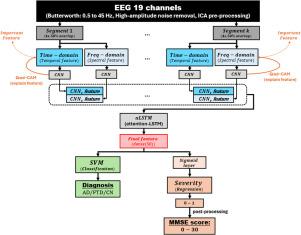利用深度学习提取和解释脑电图特征用于阿尔茨海默病和额颞叶痴呆的诊断和严重程度预测
IF 4.9
2区 医学
Q1 ENGINEERING, BIOMEDICAL
引用次数: 0
摘要
阿尔茨海默病(AD)是最常见的痴呆症形式,其特征是进行性认知能力下降和记忆丧失。额颞叶痴呆(FTD)是第二种最常见的痴呆形式,影响额叶和颞叶,导致性格、行为和语言的改变。由于症状重叠,FTD常被误诊为AD。尽管脑电图(EEG)便携、无创且成本低廉,但其对AD和FTD的诊断潜力受到两种疾病之间相似性的限制。为了解决这个问题,我们引入了一种基于脑电图的特征提取方法,利用深度学习来识别和预测AD和FTD的严重程度。主要发现包括前额和中央区域的δ带活动增加作为生物标志物。通过从脑电图信号中提取时间和频谱特征,我们的模型结合了卷积神经网络和基于注意的长短期记忆(aLSTM)网络,在区分AD和FTD与认知正常(CN)个体方面达到了90%以上的准确率。该方法预测AD的相对误差小于35%,FTD的相对误差约为15.5%。由于FTD和AD的共同特征,区分它们仍然具有挑战性。然而,应用特征选择程序提高了区分AD和FTD的特异性,将其从26%提高到65%。在此基础上,我们开发了一种两阶段的方法来同时对AD、CN和FTD进行分类。在这种方法中,首先识别CN,然后区分FTD和AD。该方法对AD、CN和FTD的分类总体准确率达到84%。本文章由计算机程序翻译,如有差异,请以英文原文为准。

Extraction and interpretation of EEG features for diagnosis and severity prediction of Alzheimer’s Disease and Frontotemporal dementia using deep learning
Alzheimer’s Disease (AD) is the most common form of dementia, characterized by progressive cognitive decline and memory loss. Frontotemporal dementia (FTD), the second most common form of dementia, affects the frontal and temporal lobes, causing changes in personality, behavior, and language. Due to overlapping symptoms, FTD is often misdiagnosed as AD. Although electroencephalography (EEG) is portable, non-invasive, and cost-effective, its diagnostic potential for AD and FTD is limited by the similarities between the two diseases. To address this, we introduce an EEG-based feature extraction method to identify and predict the severity of AD and FTD using deep learning. Key findings include increased delta band activities in the frontal and central regions as biomarkers. By extracting temporal and spectral features from EEG signals, our model combines a Convolutional Neural Network with an attention-based Long Short-Term Memory (aLSTM) network, achieving over 90% accuracy in distinguishing AD and FTD from cognitively normal (CN) individuals. It also predicts severity with relative errors of less than 35% for AD and approximately 15.5% for FTD. Differentiating FTD from AD remains challenging due to shared characteristics. However, applying a feature selection procedure improves the specificity in separating AD from FTD, increasing it from 26% to 65%. Building on this, we developed a two-stage approach to classify AD, CN, and FTD simultaneously. In this approach, CN is identified first, followed by the differentiation of FTD from AD. This method achieves an overall accuracy of 84% in classifying AD, CN, and FTD.
求助全文
通过发布文献求助,成功后即可免费获取论文全文。
去求助
来源期刊

Biomedical Signal Processing and Control
工程技术-工程:生物医学
CiteScore
9.80
自引率
13.70%
发文量
822
审稿时长
4 months
期刊介绍:
Biomedical Signal Processing and Control aims to provide a cross-disciplinary international forum for the interchange of information on research in the measurement and analysis of signals and images in clinical medicine and the biological sciences. Emphasis is placed on contributions dealing with the practical, applications-led research on the use of methods and devices in clinical diagnosis, patient monitoring and management.
Biomedical Signal Processing and Control reflects the main areas in which these methods are being used and developed at the interface of both engineering and clinical science. The scope of the journal is defined to include relevant review papers, technical notes, short communications and letters. Tutorial papers and special issues will also be published.
 求助内容:
求助内容: 应助结果提醒方式:
应助结果提醒方式:


